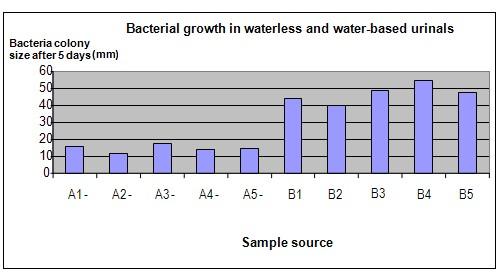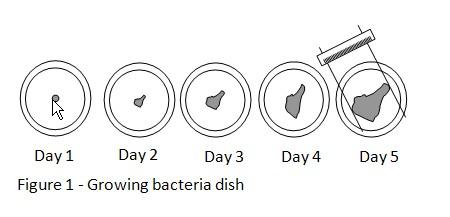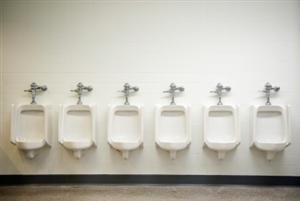| Complexity level: | 7 |
| Project cost ($): | 20 |
| Time required: | 1 day to prepare, 5 days for the science project experiment |
| Material availability: | Easily found |
| Safety concerns: | The agar in the Petri dishes should be properly disposed of and the Petri dishes decontaminated after the experiment. This can be done by washing the Petri dishes with bleach. |
Hypothesis
Waterless urinals will have less bacteria compared to the water-based urinals.
Overview
Waterless urinals
Billions of liters of water is flushed down toilet bowls and urinals daily and this drains (literally) our country’s limited fresh water resources. The water that is flushed down also needs to be treated in septic tanks and water treatment facilities before being recycled and returned to the environment. Waterless urinals are an alternative to the conventional water based flushing system. These waterless urinals help us to save water and they also incur lower maintenance costs.
The use of water in flushing causes an aerosol effect every time flushing takes place. This spreads germs all over the rest room. Waterless urinals do not use water and depend on gravity to pull the water into the drain. Waterless urinals use an oil-based deodorant liquid that filters urine and traps odors. Urine simply passes through the filter and into the waste system.
Scientific Terms
Materials
The materials required for this science fair project:
- 10 petri dishes prepared with agar
- 10 disinfected swabs
- 1 bottle of sterilized water
- latex gloves
- 1 marker pen
Procedure
1. For this science fair project, the independent variable is the sample collected from the waterless urinal and the water-based urinal. The dependent variable is the amount of bacteria growth in the Petri dishes. This is determined by measuring the approximate diameter of the growth of the bacteria colony with a ruler. The constants (control variables) are room temperature, the amount of sunlight and the petri dish preparation.
2. The 10 petri dishes are filled with agar and stored in a refrigerator. The petri dishes are taken out of the refrigerator and brought to room temperature before the start of the experiment.
3. The petri dishes are labeled A1, A2, A3, A4, A5, B1, B2, B3, B4 and B5. The petri dishes labeled A1 to A5 will be used for the waterless urinals and the Petri dishes labeled B1 to B5 will be used for the water-based urinals.
4. 5 toilets that have waterless urinals and another 5 toilets that have water based urinal are located. Once the locations of the toilets are identified, samples of bacteria are collected from each toilet.
5. The 5 waterless urinals are tested first. A sterilized swab is moistened using some sterilized water. The swab is dabbed onto the walls inside the urinal and then dabbed on the surface of the agar inside Petri dish labeled A1. Similarly, petri dishes A2 to A5 are used to collect bacteria samples from the other 4 waterless urinals. The 5 petri dishes are sealed with their cover and they are set aside in a cool shaded place to allow the bacteria to grow.
6. The 5 water-based urinals are next tested. Bacteria samples are collected in the same way described in procedure 5 (from the same spot within the urinal) and the swabs are rubbed onto the surface of the agar in petri dishes labeled B1 to B5.
7. The approximate diameter of the bacteria colony growth is measured everyday for 5 days and recorded in the table below.


Results
The results show that petri dishes in Group A which contain samples from waterless urinals have a smaller amount of bacterial growth compared to petri dishes in Group B which contain samples from water based urinals.
| Petri dish | bacteria growth (mm) | ||||
| Day 1 | Day 2 | Day 3 | Day 4 | Day 5 | |
| A1 - waterless | 0 | 2.5 | 6.7 | 9.8 | 15.7 |
| A2 - waterless | 0 | 2.4 | 4.8 | 8.2 | 11.4 |
| A3 - waterless | 0 | 3.9 | 6.9 | 11.2 | 17.3 |
| A4 - waterless | 0 | 2.6 | 5.3 | 9.3 | 13.9 |
| A5 - waterless | 0 | 3.5 | 5.5 | 9.8 | 14.8 |
| B1 – water based | 5.2 | 11.7 | 22.4 | 31.8 | 43.7 |
| B2 – water based | 3.4 | 11.7 | 19.9 | 28.4 | 39.8 |
| B3 – water based | 6.1 | 13.8 | 25.7 | 37.5 | 48.6 |
| B4 – water based | 4.3 | 15.3 | 28.4 | 41.4 | 54.8 |
| B5 – water based | 3.7 | 12.3 | 23.5 | 35.9 | 47.3 |
The graph below represents the results of our science experiment.

Conclusion
The hypothesis that waterless urinals will have less bacteria compared to water based urinals, is proven to be true.
Waterless urinals help to reduce water wastage and also help to lower the cost of treating waste water. In addition, they are more hygienic and are odor free. Moreover, since there is no need for flush valves and external water sources, the maintenance cost is also lower.
Also consider
This science fair project can be modified by collecting bacteria samples from other areas around the urinals such as from the floor, walls or wash basins near the urinals.
Also, to produce more accurate results, you might want to consider collecting swab samples from at least 5 different spots/locations within each urinal.
References
Characteristics of a waterless urinal - http://www.ehow.com/list_5965246_characteristics-waterless-urinal.html
Waterless urinals: features, benefits and application - http://www.atypon-link.com/CPUB/doi/abs/10.3992/jgb.1.1.55?cookieSet=1&journalCode=jgb

